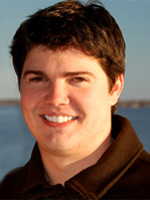Michael McDonald

Dr. Michael McDonald is a Hubble postdoctoral fellow at the Kavli Institute for Astrophysics and Space Research at the Massachusetts Institute of Technology. He graduated with Bachelors degrees in Mathematics and Statistics (2004) and Astrophysics (2005), and a Masters of Science (2007) from Queen's University in Canada, and received his PhD from the University of Maryland (2011). Dr. McDonald has been involved in over 25 published scientific papers; over half of these since arriving at MIT in July 2011. His scientific interests include the observation and study of clusters of galaxies, individual galaxies, and the intracluster plasma that fills the space between galaxies. His research, which requires the use of a wide variety of data from both space- and ground-based telescopes, hopes to shed new light on how the million degree plasma between galaxies cools and condenses to form new stars, as well as on the surprisingly delicate balance between the cooling intracluster gas and heating from black hole jets, and how this balance has evolved throughout the age of the Universe.
Bradford Benson

Dr. Bradford Benson is a postdoctoral fellow at the Kavli Institute for Cosmological Physics at the University of Chicago. He graduated from the University of Wisconsin-Madison in 1999, received his PhD in physics from Stanford University in 2004, and was first a postdoctoral researcher at the University of California-Berkeley. Dr. Benson has published over 50 scientific papers. His scientific interests include clusters of galaxies, sub-mm and mm-wavelength detector development, and measurements of the cosmic microwave background, the 14 billion year old light left over from the Big Bang. His main goals are to develop instrumentation and make observations that can answer some of the biggest questions in cosmology: What physics was responsible for the Big Bang? What is Dark Energy? What is the mass of the neutrino? How did they affect the growth of the largest structures in the Universe?
Megan Donahue

Megan Donahue is currently a professor of physics and astronomy at Michigan State University (MSU) in East Lansing, Michigan. Her main research interests include galaxy formation and cosmology, particularly relating to X-ray, UV, and infrared observations of clusters of galaxies. She earned her SB in physics from the Massachusetts Institute of Technology, and a PhD in astrophysics from the University of Colorado Boulder. She received the Trumpler Prize for her dissertation from the Astronomical Society of the Pacific in 1992. She was a Carnegie Fellow at the Observatories for the Carnegie Institution of Washington in Pasadena, CA (1990-1993) and STScI Fellow at the Space Telescope Science Institute (1993-1995). She was a staff astronomer at STScI from 1995-2003 working in the Hubble data archive and on the James Webb Space Telescope, and moved to MSU in 2003. She is a Fellow of the American Association for the Advancement of Science and has served on multiple NASA/ESA reviews for the Hubble Space Telescope, Spitzer, Chandra, XMM/Newton Telescopes, National Academy of Sciences and the National Research Council committees, including the 2010 Decadal Review for Astronomy.
Martin Rees

Martin Rees is Professor of Cosmology and Astrophysics at the University of Cambridge and holds the honorary title of Astronomer Royal. After studying at Cambridge, he held post-doctoral positions in the UK and the USA, before becoming a professor at Sussex University. During 1973-91, he was Plumian Professor of Astronomy at Cambridge and served for ten years as director of Cambridge's Institute of Astronomy. From 1992 to 2003 he was a Royal Society Research Professor. In 2004 he became Master of Trinity College. His main research interests are: high energy astrophysics; cosmic structure formation (especially the earliest stages at high redshift); and general cosmological issues.


